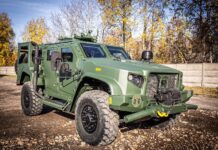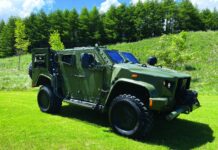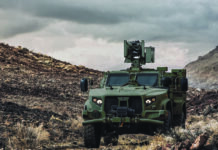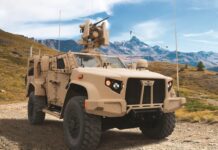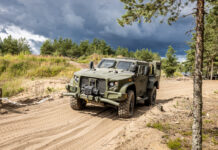Oshkosh Defense is a global company designing and producing military vehicles and mobility platforms. For over 100 years, Oshkosh has designed, tested and manufactured a robust portfolio of heavy, medium, light and highly protected military vehicles and technologies. ESD had the opportunity to talk to John Lazar, Vice President and General Manager, International Programs, Oshkosh Defense.
ESD: Where next for JLTV?
Lazar: First, continued growth. To date, Oshkosh has built and delivered over 14,600 JLTVs which have been fielded to over 40 locations around the globe. Then, international expansion: We continue to see international interest in the Oshkosh JLTV, with orders or commitments from eight NATO, allied and coalition partners including Belgium, Montenegro, Slovenia, Lithuania, Brazil, Romania, North Macedonia and the United Kingdom.
Third, lethality and mobility demonstartions: The past 12 months were filled with dynamic demonstrations and live fires across Europe. 2022 will be just as exciting with several more live fire and dynamic events planned. Our teams have a robust pipeline of new opportunities and are preparing to participate in procurement programmes in Greece, Romania, the Netherlands and more. Integrated lethality on an agile and protected vehicle like the JLTV is quickly filling capability gaps that exist in many international militaries.
The recent Rafael SPIKE NLOS live fire demonstration in Estonia provided an example of vehicle-based coastal defence applications which compliment some of the earlier live firings of SPIKE LR on both the Kongsberg PROTECH RWS and the SAMSON RCWS.
Additionally, the United States Marine Corps (USMC) has integrated the MADIS system onto the JLTV. The MADIS system uses two JLTVs per section that work together to attack and destroy enemy fixed-wing aircraft, helicopters, and unmanned aerial vehicles (UAVs).
It was also recently reported that the USMC will use HERO-120 loitering munitions for the USMC Organic Precision Fire Mounted (OPF-M) System on the JLTV. The HERO-120 is a mid-range, anti-armour weapon system that carries out pinpoint strikes against its targets.
Finally, Oshkosh has been working with Elbit Systems Land Division to qualify a low recoil 120mm mortar on the JLTV platform. The results from manned firings are quite impressive. There are more than 10 other projects with US and International system manufacturers that our teams are engaged in daily that will be announced later in 2022.
Last but not least, ROGUE Fires: Oshkosh Defense’s work on ROGUE Fires is another example of how we’re evolving the JLTV’s capabilities to meet the demands of our customers. ROGUE Fires is an Unmanned Ground Vehicle (UGV) that leverages the JLTV’s extreme mobility and payload capacity and Oshkosh’s advanced autonomous vehicle technologies to support Ground Based Anti-Ship Missile (GBASM) operations. In August 2021 Oshkosh Defense demonstrated the JLTV-based Remotely Operated Ground Unit for Expeditionary (ROGUE) Fires as part of the U.S. Navy’s Large-Scale Exercise 2021, Sink at Sea Live Fire Training Exercises (SINKEX). As part of the demonstration, a Navy Marine Expeditionary Ship Interdiction System (NMESIS) launcher, based on a ROGUE Fires chassis, successfully launched a Naval Strike Missile (NSM) and scored a direct hit on a target at sea. The successful demonstration validates the maturity of ROGUE Fires as a weapons platform and highlights its ability to add significant firepower and capability into the light tactical wheeled vehicle fleet.
ESD: What comes after JLTV? What else do you have on offer besides JLTV?
Lazar: We are committed to providing the best possible solutions to the US military and its allies for their evolving modernisation priorities. As a leading innovator of defence technologies, Oshkosh Defense has won several recent contract awards that highlight the company’s expansion into adjacencies. This includes contracts with the US Army for the STRYKER Medium Caliber Weapon System (MCWS) and Optionally Manned Fighting Vehicle (OMFV). While MCWS and OMFV may not seem like typical Oshkosh programmes, they are perfect examples of our ongoing commitment to provide solutions for the US military’s ongoing needs —and proof that Oshkosh Defense is more than a TWV manufacturer.
As we grow our portfolio, our top priority is to listen to our customers and deliver against their requirements for purpose-built solutions designed for current and future missions.
ESD: What about UGV developments?
Lazar: Oshkosh Defense has over a decade of experience developing autonomous technology and is currently supporting several important US military modernisation efforts.
Since 2015, the Ground Vehicle Systems Center (GVSC) (formerly Tanks and Automotive Research Development Center [TARDEC]) has been working with an industry team including Oshkosh Defense, Robotic Research, and DCS Corporation, for the Autonomous Ground Resupply (AGR) project and the Expedient Leader-follower (ExLF) projects with focus on validating leader-follower concepts for autonomous convoy implementation. Leader-follower technology serves to remove personnel from at-risk vehicles in often-targeted convoy routes. This increases the threat standoff and enhances crew protection while providing force multiplication by reducing the number of personnel performing logistics convoy missions in contested areas of operation.
Also, Pratt Miller, a wholly owned subsidiary of Oshkosh Defense, developed the Expeditionary Modular Autonomous Vehicle (EMAV) platform in conjunction with the Marine Corps Warfighting Lab (MCWL). Pratt Miller leverages the EMAV platform for the current phase of the US. Army’s Robotic Combat Vehicle-Light (RCV-L) programme. EMAV and RCV-L are both undergoing end user experimentations with their respective services.
The interview was conducted
by Stephen Barnard.








